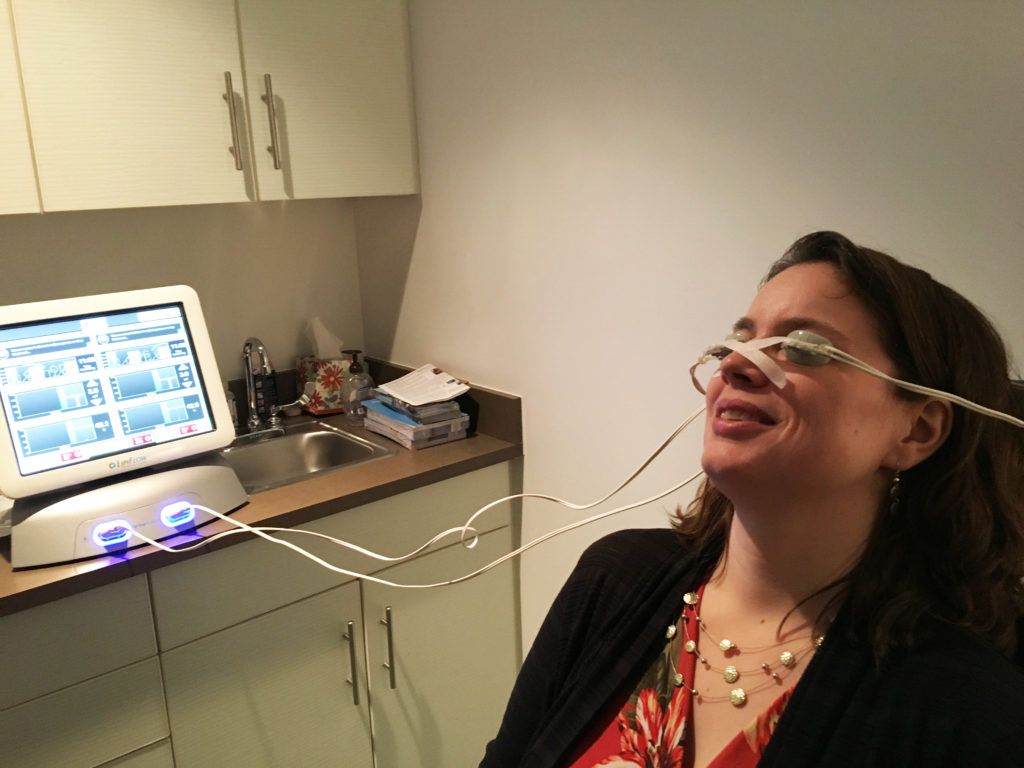
Dr. Huffer’s practice partner, Kelly MacDonald, OD, receives dry eye treatment using LipiFlow technology that was invested in to better serve dry eye patients. Dr. Huffer says major capital investments like this require systematic budgeting and planning to ensure ROI is delivered.
By Scott Huffer, OD, FAAO
April 26, 2017
Practice growth doesn’t happen by accident. It requires a plan in which owners decide on what will be invested in to better serve patients and the practice, and how the money that’s generated will be further invested, or put toward savings for later needs.
I would define a practice growth plan as a set of actions to grow the most under-performing areas of the business, or generate new business. The elements of the plan should be practice- and goal-specific.
Review Recent Practice Metrics
The first step in setting up a plan is to review carefully and thoroughly how the office did over a period of time. Year-end is the perfect time to look back over the year and reflect. We use many different software tools to help us do this, and they each have their strengths and weaknesses. We use RevolutionEHR and its Fitify program of team coaching, along with other practice management software.
We are currently considering another piece of software called Practice Jet. As you look over certain metrics you will see some that stand out. For example, in our most recent metrics, we noticed our revenue per frame sold was particularly low. We shared this with our opticians and discussed potential solutions. We decided to raise frame prices slightly, and cap one of our lower reimbursing vision plans to existing patients only. This, combined with our increased focus, has our average revenue per frame numbers up approximately 30 percent.
Define “Success”
It’s important to be able to say, at least in general, or “more-than” terms, what success means for any investment. For example, about a year and a half ago we added another associate OD. We created a marketing plan with the help of a marketing firm, and defined success as a booked new OD in 1-1.5 years. We spent $5,000-$7,000 on marketing, and she is currently booked a few days out. It is hard to define the ROI on this exactly, but I can be sure it will not be less than four times the investment.
A few years ago, we decided to change the name of the office. We decided to move away from using personal names in the business name. To do this, we allocated a significant amount of money to marketing, and hired a marketing company. We worked together to develop a transition plan from one name to the next. I cannot quantify exactly our return on our marketing dollars, but we have been seeing many more new patients since that time. I also think, given only two of the now five partners names were in the business name, it allows better consistency in the business.
Allow for Flexibility
Always start with the goal. Pick and choose action items as the budget allows, but do not be afraid to spend money. For instance, we invested in a Lipiflow unit last fall. We did not have a lot in the budget to market the device. Further, we really needed to add a team member to fully incorporate the device. We have worked in stages. We have worked a portion of this year’s marketing budget to promote Lipiflow, and plan to host a dry eye open house this fall for local primary care physicians and local ODs in the hope of referrals. We also recently added another support staff member, a technician formerly with a large ophthalmology group. Our goal with this hire is for her to better organize and train our technicians, enabling us to more fully utilize instruments like our LipiFlow machine.
Ask Staff for Input on Needed Investments
We have monthly staff meetings, and quarterly half-day meetings, to encourage staff members to try and better the office. We value their ideas when discussing challenge areas in the office, and possible solutions.
Staff buy-in when making a new investment is essential to success. When we took on a new OD, our staff understood the importance of growing her schedule, and its connection to the success of the office.
Make the Decision, Align with Partners
Generally, my four practice partners, and I, look over the data from various reports and debate the best area to focus on. The reports take emotion out of the discussion. We were slightly torn between two areas this year, but chose based on one being easier to implement, and the other having a fair amount of risk for a poor return.
Some partners are more fiscally conservative than others, and this limits how quickly we can implement change. We usually find middle ground, and make slow change. I think the decisions of the group fare better than any one of us would independently.
Know When to Wait and See
Adding staff members is something we are evaluating. We are adding an ophthalmic technician in the next month, and have recently booked our accountant for more hours. These investments will generate revenue, and not deplete resources, but it is important to not add too much salary all at once.
We are newly working with Fitify, and anticipate getting a lot more outside feedback and guidance from this service, along with accountability to ensure our targets are hit. My next growth plan involves finalizing the practice name transition and a web site overhaul. I believe a strong focus on proper staffing will be essential soon, and I believe it will be imperative to improving our capture rate.
 Scott Huffer, OD, is a partner with with Drs. Helfman, Lasky & Associates in Nashua, N.H. To contact: eyedocscott@gmail.com
Scott Huffer, OD, is a partner with with Drs. Helfman, Lasky & Associates in Nashua, N.H. To contact: eyedocscott@gmail.com

























